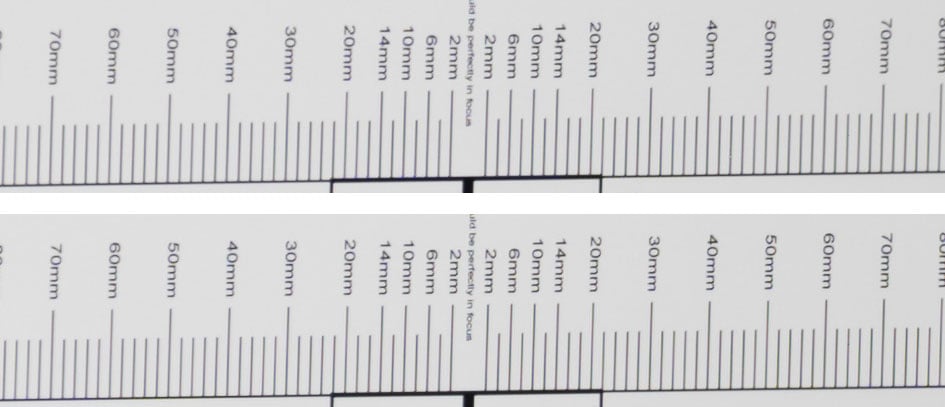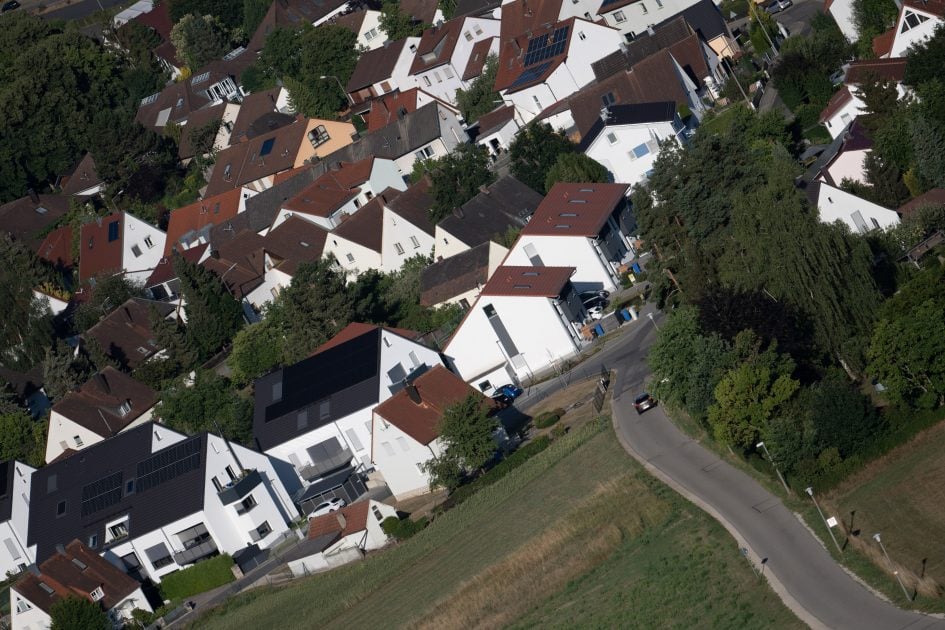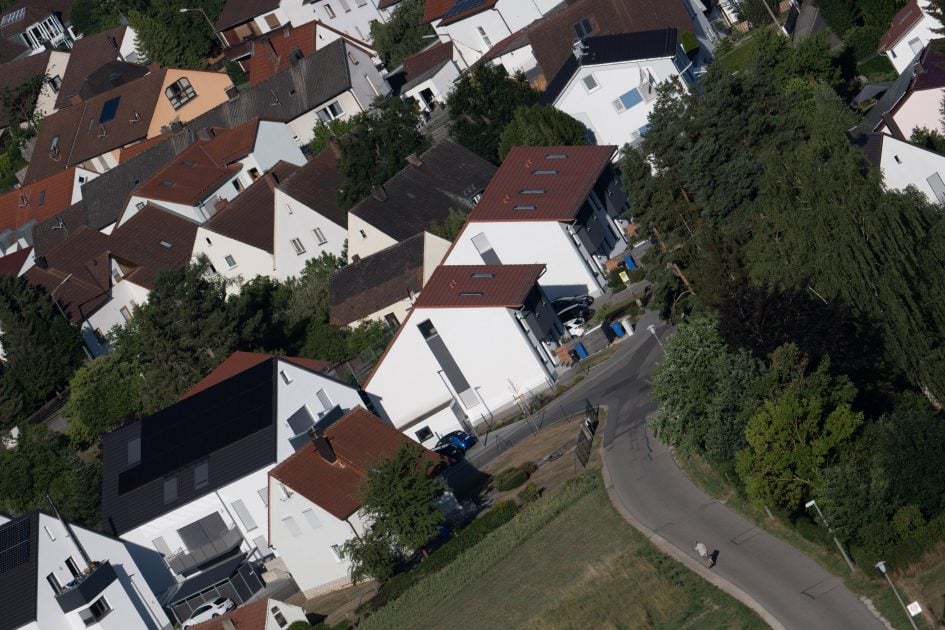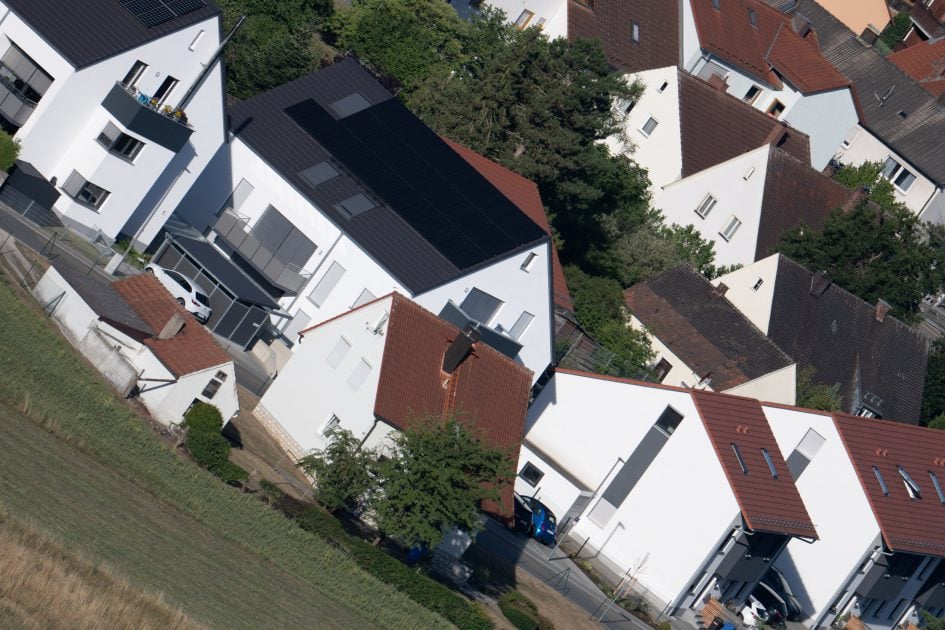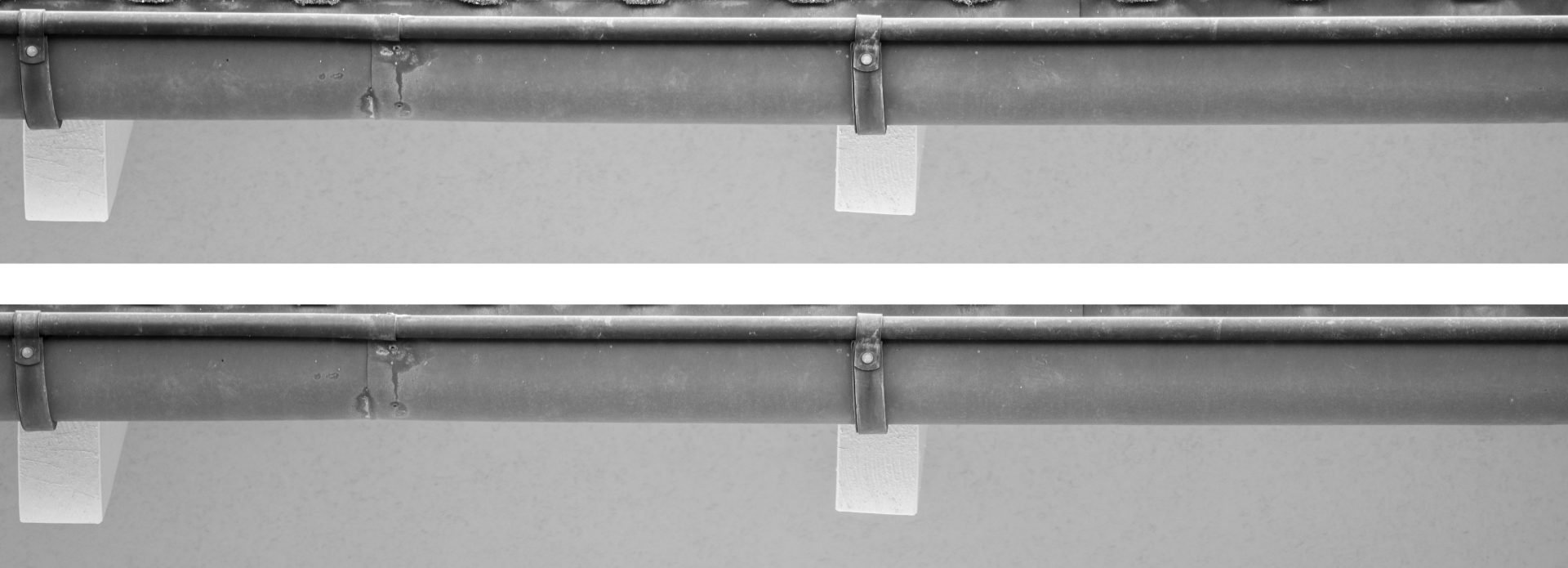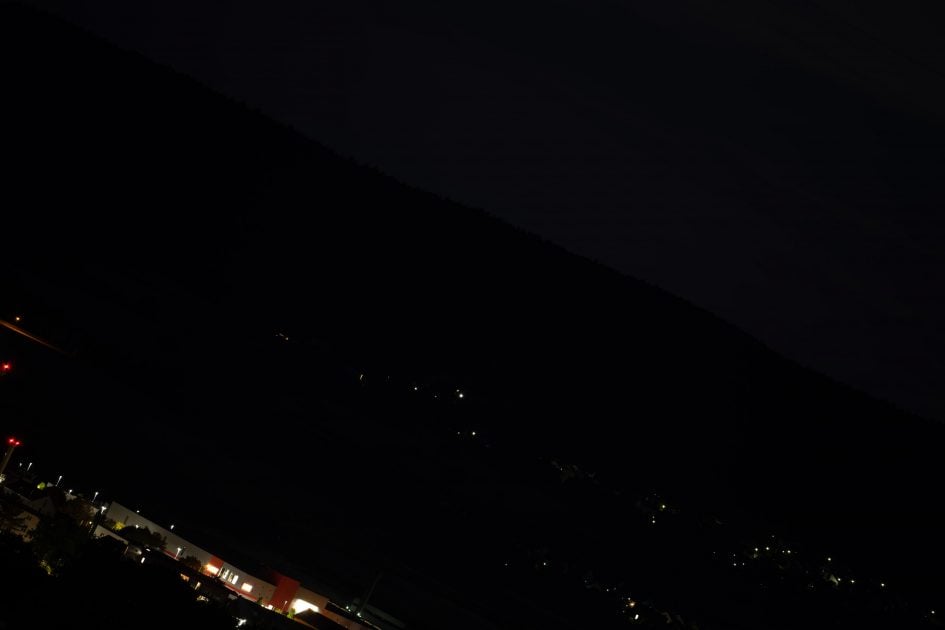Nikon Z 400mm f4.5 VR S review
-
-
Written by Thomas
Quality
Longitudinal Chromatic Aberration and focus shift
Longitudinal color aberrations (loCA, a.k.a. “axial color” or “bokeh CA”) cannot be easily corrected in post-processing. They show up as magenta coloration in the foreground and greenish hues in the background. But in my tests the new Z-Nikkor showed no discernible loCA. When stopped down background and foreground becomes equally sharper.
Nikon Z 400mm f4.5 VR S longitudinal Chromatic Aberration (loCA)
Above from top to bottom: f4.5, f5.6; left = foreground, right = background, click image for 100% crops
In all of my test-shots with the Nikon Z 400mm f4.5 VR S I could not detect any purple fringing around high-contrast edges in the focus plane and no green outlining around background subjects. Very good!
Sharpness and contrast
Let’s have a look at the theoretical performance of Nikon’s Z 400mm f4.5 VR S and compare it to their Z 100-400mm f4.5-5.6 RV S zoom lens at the long end, the Z 400mm f2.8 TC VR S, and the F-Nikkor AF-S 500mm f5.6E PF ED VR:
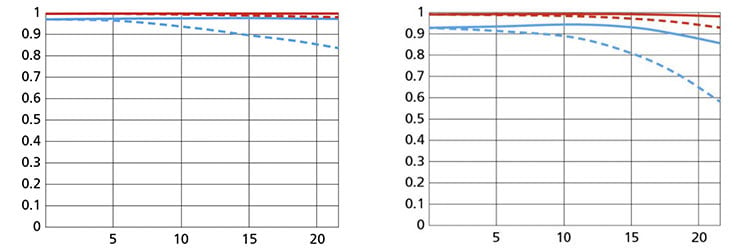
Above: Nikon Z 400mm f4.5 VR S at f4.5 (left), Nikon Z 100-400mm f4.5-5.6 VR S at 400mm f5.6 (right)
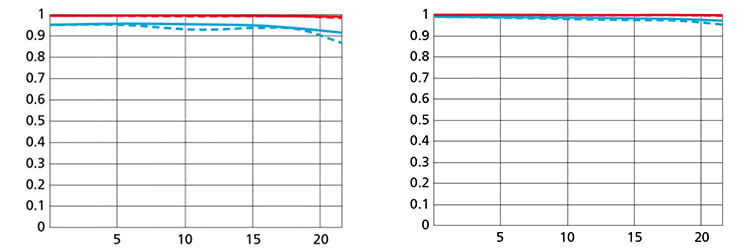
Above: Nikon Z 400mm f2.8 TC VR S at f2.8 (left), Nikon AF-S 500mm f5.6E PF ED VR at f5.6 (right)
These MTF charts show the computed lens-performance of lenses wide open at infinity without influence of diffraction at 10 line-pairs/mm (red) and 30 lp/mm (blue). Higher values are better (more contrast) and the closer the dotted and solid lines are together the less contrast dependents on the orientation of the test-pattern (less astigmatism). The x-axis displays the distance from the optical axis (=center of the sensor) in mm. I’ll show you real-life performance at 4 mm (“center”), 13 mm (APS-C/DX-corner), and 20 mm (FF/FX-corner) on a on a 45MP Nikon Z7 camera.
From the charts all four lenses show extremely high overall contrast (red lines). Looking at the resolution of finer details (30 lp/mm) the new Z 400mm f4.5 VR S is clearly superior at f4.5 to the Z 100-400mm at f5.6 – which bodes well for using the Z TC-2.0x. The Nikon Z 400mm f2.8 TC VR S looks just a little less sharp on paper but shows less astigmatism and also is at f2.8. Stop it down to f4.5 for an apples-to-apples comparison and I’m pretty sure it’s right up there with or even superior to the Z 400mm f4.5 VR S. The best looking chart in this comparison belongs to the F-Nikkor AF-S 500mm f5.6E PF ED VR. But keep in mind that the lens is at f5.6 which makes it much easier to produce good mtf values – especially when diffraction is not taken into account.
Let’s see how this theoretical performance translates into real life results in the sharpness test based on Siemens-stars shot on a 45MP Nikon Z7. Processing was done in Lightroom 11.4.1/CRAW 14.4.1 from RAW to Adobe Color profile with the built-in lens profile for CA, vignette control and distortion compensation applied. Noise-reduction is set to 0, sharpening to 50/0.5/36/10, with no extra tone, color, or saturation adjustment. White-balance was adjusted to a neutral white and I did some exposure compensation to make the brightness of all crops match. So you will not see light fall-off in the corners.
The following are all 100% crops!
First up is an overview of the wide-open performance at 400mm, 560mm, and 800mm shot with the Nikon Z TC-1.4x and TC-2.0x. You can jump to the detailed results at different apertures and comparisons with other lenses by clicking on the crops of the respective focal length.
Nikon Z 400mm f4.5 VR S; 100% crop from center, DX-corner, FX-corner
Above: 400mm, f4.5
Above: 560mm, f6.3 (with Z TC-1.4x)
Above: 800mm, f9.0 (with Z TC-2.0x)
Without teleconverter Nikon’s Z 400 TC impresses with extremely even and high sharpness across the full-frame sensor even wide open. The lens still performs very good with the Z TC-1.4x but the Z TC-2.0x makes results visibly softer. The decline in acuity is especially visible in the center while the DX-corner seems to hold up a tad better.
Field curvature is practically a non-issue with the lens. I could have taken all crops in a row from a single shot with very little difference in resolution.
The following crops show the Nikon Z 400mm f4.5 VR S from wide open down to f11 compared to the Nikon Z 400mm f2.8 TC VR S, Nikon Z 100-400mm f4.5-5.6 VR S, and Nikon AF-S 500mm f5.6E PF VR at 400mm, 560mm, and 800mm focal length.
At 400mm I also put the Nikon Z 70-200mm f2.8 VR S plus Z TC-2.0x in for comparison.
If you want to see all the details and comparisons read on. Or you can fast-forward to the performance at long distances.
Performance at 400mm:
Nikon Z 400mm f4.5 VR S at 400mm compared; 100% crop from center, DX-corner, FX-corner

Above: Nikon Z 400mm f4.5 VR S at f4.5

Above: Nikon Z 400mm f2.8 TC VR S at f4.0

Above: Nikon Z 400mm f4.5 VR S at f5.6

Above: Nikon AF-S 500mm f5.6E PF VR at f5.6

Above: Nikon Z 100-400mm f4.5-5.6 VR S at 400mm, f5.6

Above: Nikon Z 70-200mm f2.8 VR S + Z TC-2.0x at 400mm, f5.6

Above: Nikon Z 400mm f4.5 VR S at f8; also available at f11
The clear winner in this comparison is the Z 400mm f2.8 TC VR with its outstanding clarity. Even stopping the Z 400mm f4.5 VR S down to f5.6 cannot match performance of the Z 400 TC at f4.0. Looking at the other alternatives at f5.6 shows that they are pretty close which is in descending order: AF-S 500mm f5.6E PF VR, Z 100-400mm f4.5-4.5 VR S, Z 70-200mm f2.8 VR S + Z TC-2.0x.
Performance at 560mm:
Nikon Z 400mm f4.5 VR S + Z TC-1.4x at 560mm compared; 100% crop from center, DX-corner, FX-corner

Above: Nikon Z 400mm f4.5 VR S + Z TC-1.4x at 560mm, f6.3

Above: Nikon Z 400mm f2.8 TC VR S + internal 1.4x TC at 560mm, f5.6

Above: Nikon AF-S 500mm f5.6E PF VR at 500mm, f5.6

Above: Nikon Z 400mm f4.5 VR S + Z TC-1.4x at 560mm, f8.0

Above: Nikon Z 100-400mm f4.5-5.6 VR S + Z TC-1.4x at 560mm, f8.0

Above: Nikon Z 400mm f4.5 VR S + Z TC-1.4x at 560mm, f11
Putting the Z TC-1.4x on (except for the AF-S 500mm f5.6E PF VR) softens the lenses all up a bit but the overall ranking stays the same.
Performance at 800mm:
Nikon Z 400mm f4.5 VR S + Z TC-2.0x at 800mm compared; 100% crop from center, DX-corner, FX-corner

Above: Nikon Z 400mm f4.5 VR S + Z TC-2.0x at 800mm, f9.0

Above: Nikon Z 400mm f2.8 TC VR S + Z TC-2.0x at 800mm, f8.0

Above: Nikon Z 800mm f6.3 VR S at 800mm, f8.0

Above: Nikon AF-S 500mm f5.6E PF VR + AF-S TC-17E II at 850mm, f9.5

Above: Nikon Z 400mm f4.5 VR S + Z TC-2.0x at 800mm, f11

Above: Nikon Z 100-400mm f4.5-5.6 VR S + Z TC-2.0x at 800mm, f11
At 800mm the clear winner is the Z 800mm f6.3 VR S – although the Z 400mm f2.8 TC VR S + Z TC-2.0x still has a small advantage in center sharpness. The AF-S 500mm f5.6E PF VR (now with 1.7x TC at 850mm) stays close to the Z 400mm f4.5 VR S – and even the Z 100-400mm f4.5-5.6 VR S is not far behind (at f11).
Performance at long distances
The Siemens-star test-targets are shot at a distance of 45x focal length (i.e. at around 18m for 400mm focal length). But performance of lenses also depends on the shooting distance. Therefore I present another series of images shot on a 45MP Nikon Z 7 of a city around 1 km away. Processing was done in Lightroom 11.4.1/CRAW 14.4.1 from RAW to Adobe Color profile with the built-in lens profile compensating CA, vignetting, and distortions. Noise-reduction is set to 0, sharpening to 50/0.5/36/10, with no extra color or saturation adjustment. All shots were made from a heavy tripod with image stabilization switched off and I used ISO 200 for 400mm and 560mm focal length and ISO 400 for 800mm focal length to keep shutter speeds fast enough even at f11 to minimize any risk of micro-blur from gusts of wind. As usual I selected the diagonal which provided the better corner results. This may not necessarily indicate decentering of the lens as thermal turbulences in the air might also influence sharpness of different shots. Overall my test-copy of the lens made a well-centered impression.
The following images show the complete scene wide open plus 100% crops roughly from the center, DX-corner, and FX-corner at 400mm, 560mm, and 800mm. You can access the large originals but these files are for personal evaluation only and cannot be used in another publication or website without permission..
Nikon Z 400mm f4.5 VR S
Above: Nikon Z 400mm f4.5 VR S at f4.5; click image for 4k version, here for large original; crops also available at f5.6, f8.0, f11
Above: Nikon Z 400mm f4.5 VR S + Z TC-1.4x at 560mm, f6.3; click image for 4k version, here for large original; crops also available at f8.0, f11
Above: Nikon Z 400mm f4.5 VR S + Z TC-2.0x at 800mm, f9.0; click image for 4k version, here for large original; crops also available at f11
The Nikon Z 400mm f4.5 VR S again proves that it can easily produce sharp shots wide open – even right into the FX-corner with the Z TC-1.4x at 560mm. With the Z TC-2.0x at 800mm results become a bit softer but are still very usable.
Both short and long distance tests prove that the Nikon Z 400mm f4.5 VR S is indeed a very good performer. It also works well with the Z TC-1.4x. But matching it with the Z TC-2.0x is taxing the abilities of the lens a bit: Especially the center is not significantly better than the Z 100-400mm f4.5-5.6 VR S + Z TC-2.0x – which is quite revealing. But don’t get me wrong: Head over to my samples page where a lot of images were shot with the Z TC-2.0x at 800mm f9.0 and you’ll find that even the thinnest hairs on the nose of a zebra or the neck of a vulture are reproduced in sharp detail.
Vignetting and distortions
To make it easier to see light fall-off in the corners of a full-frame sensor I’ve arranged a series of three shots each with the Nikon Z 400mm f4.5 VR S. All images were developed to the same brightness in the center and are shown with vignette control Off (1st row) resp. Normal (2nd row):
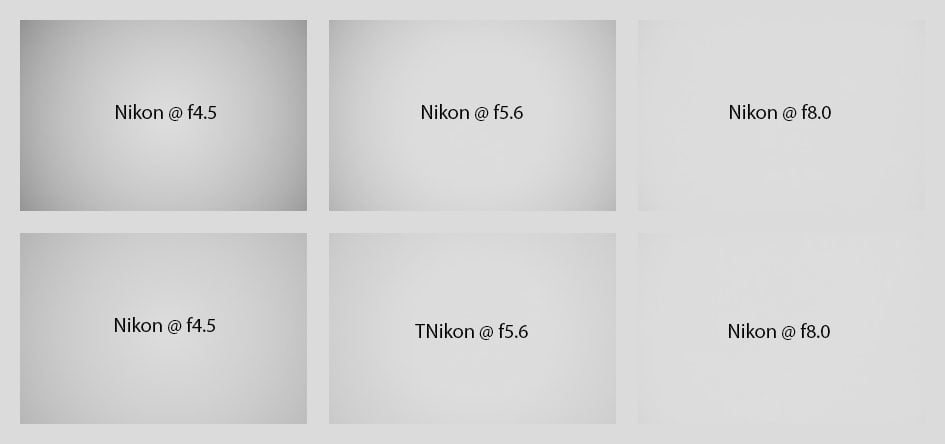
Above: Nikon Z 400mm f4.5 VR S
Wide open vignetting is pretty mild even without lens profile. With vignette control set to normal the extreme corners are lifted about 0.5 EV when the aperture is wide open. How Adobe’s RAW converter and Lightroom handle the built-in lens-profiles is a bit of a mess – and depends on whether you use a Z7 or a Z9:
With RAW-files from a Z7 the converter automatically applies vignette control as it was set in camera – but you cannot alter the setting in postprocessing. The setting for distortion compensation in camera is ignored by Adobe’s RAW converter, treated as On, and cannot be deactivated.
With RAW-files from a Z9 Lightroom let’s you activate or deactivate the lens profile and adjust the strength of vignetting and distortion control between 0% and 200%. Unless you had vignetting control switched off in camera: In this case Lightroom does not allow to activate vignetting control in post-processing.
Oh, and lest I forget: The compensation of (lateral) chromatic aberrations at least can always be activated or deactivated separately. Funny thing is: Even if the information button claims (on Z7 RAW-files) that CA compensation is already applied it is NOT – unless you check the box.
The following composite images show a roof rail at the upper border of the full-frame image first without distortion compensation and then with compensation from the built-in lens profile applied to RAW:
Distortions: Nikon Z 400mm f4.5 VR S, auto distortion control Off (top), On (bottom)
Rendering of point-light sources at night-shots
Night-shots pose a different challenge for lenses as the contrast is even higher than under bright sun and point-light sources can reveal some weaknesses such as coma, haloing and colour-aberrations that do not show up as prominently in other test-shots. The 100% crops below the main image show the effect of coma in the FF-corner of the Nikon Z 400mm f4.5 VR S at different apertures:
Above: Nikon Z 400mm f4.5 VR S at f4.5; click image for 4k version, here for large original

Above: Nikon Z 400mm f4.5 VR S; 100% crops from the FX-corner at f4.5 (left), f5.6 (middle), f8.0 (right)
There’s practically no coma at the edge of the Z 400mm f4.5 VR S image-circle and the lens also produces no color artifacts around bright streetlights. Very good!
Bokeh quality
This test is for the rendering of point-light sources in an out-of-focus background. The circle of confusion that is produced by the test is pretty indicative of Bokeh performance (in the background) and light fall-off. Ideally the out-of-focus image of the point-light is evenly lit and perfectly circular, with no “onion-rings”, and without coloration. Large aperture lenses normally produce an effect known as “cat’s eye” the further away from the optical axis the point-light is projected. This is due to optical vignetting in the lens barrel when light enters the lens from an angle.
Above: Nikon Z 400mm f4.5 VR S at f4.5; 4k versions available at f4.5, f5.6, f8.0, f11
Note: The diameter of the Bokeh balls in the center is determined by the entrance pupil of the lens which is 89mm. So the Bokeh balls of the Nikon Z 400mm f2.8 TC VR S should be 60% larger. But if you look at the respective image in my review you’ll see they are actually smaller. This is caused by differences in focus/magnification: I focused the Z 400mm f4.5 VR S much closer than the Z 400mm f2.8 TC VR S – hence the larger Bokeh balls.
Back to the Nikon Z 400mm f4.5 VR S: Compression of the circle towards the corners is OK wide open. The circle of confusion clearly shows the aperture blades from f5.6 onwards – which should produce good diffraction spikes. There is not much outlining and no coloration from loCA. The inside of the Bokeh balls is smoothly textured with no onion rings. These are all good preconditions for a soft Bokeh.
Head over to my page with sample images which were all shot wide open to get a better impression of how Bokeh of the lens looks in different situations. I personally find it smooth in the transition zone and no double contours marring the background.

Above: Nikon Z 400mm f4.5 VR S at f4.5; click image for 4k version, here for large original
Above: Nikon Z 400mm f4.5 VR S at f4.5; click image for 4k version, here for large original
Close-up performance
The following shots were taken with the Nikon Z 400mm f4.5 VR S at its maximum magnification of 1:5.6. The crops shown below are from 0mm, 11mm, and 18mm off the center of the sensor respectively, the area of sharp focus is 134 x 202mm.
Nikon Z 400mm f4.5 VR S, 1:5.6 magnification; 100% crops

Above: Nikon Z 400mm f4.5 VR S at f4.5

Above: Nikon Z 400mm f4.5 VR S at f8.0

Above: Nikon Z 400mm f4.5 VR S at f16
At 400mm focal length close-up performance is quite decent – even wide open. Stopping down to f8.0 improves corners a bit. Field curvature is very low, in this test all crops are from the same shot.
I repeated the test with the Z TC-2.0x at 800mm focal length and a magnification of 1:2.8. The crops are from 0mm, 14mm, 20mm image height, the area of sharp focus is 67 x 101mm. Results are quite a bit softer than at 400mm but still produce very usable results in the DX image-circle. F11 seems to be the best compromise for sharpening the lens up before diffraction takes its toll.
Nikon Z 400mm f4.5 VR S + Z TC-2.0x at 800mm, 1:2.8 magnification; 100% crops

Above: Nikon Z 400mm f4.5 VR S + Z TC-2.0x at 800mm, f9.0

Above: Nikon Z 400mm f4.5 VR S + Z TC-2.0x at 800mm, f11

Above: Nikon Z 400mm f4.5 VR S + Z TC-2.0x at 800mm, f16
Sun-stars
The lens produces sunstars already at f5.6. I’m not sure though what causes the changing form of the sunstars when the lens is stepped down.
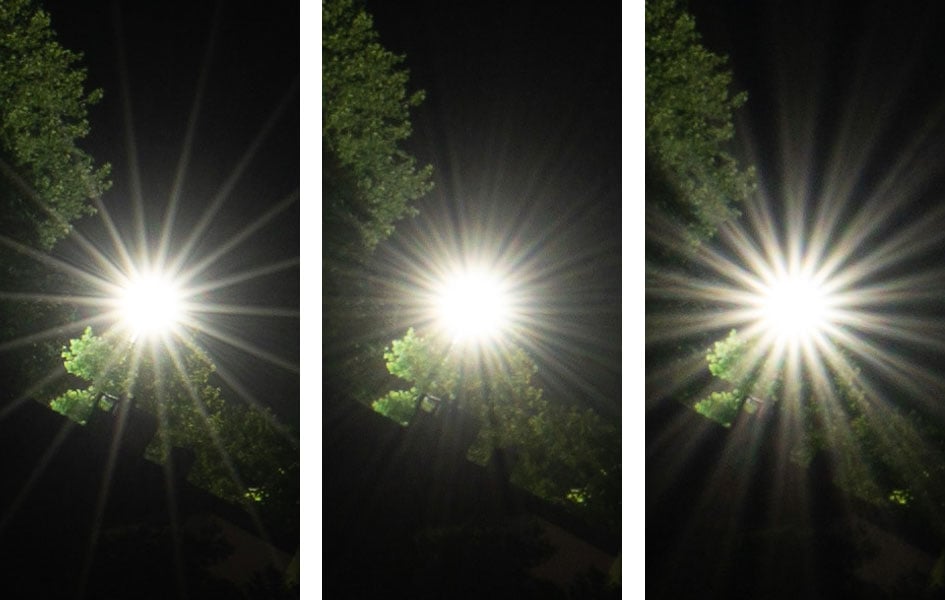
Above: Sunstars from the Nikon Z 400mm f4.5 VR S at f5.6, f8.0, f11 (from left to right), 100% crops
Next check out my sample images!
Check prices on the Nikon Z 400mm f4.5 VR S at B&H, Adorama, WEX UK or Calumet.de. Alternatively get yourself a copy of my In Camera book, an official Cameralabs T-shirt or mug, or treat me to a coffee! Thanks!